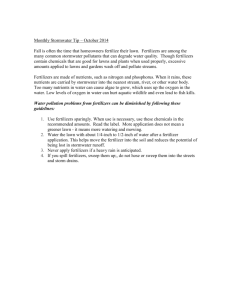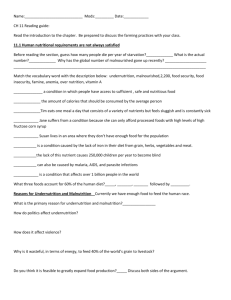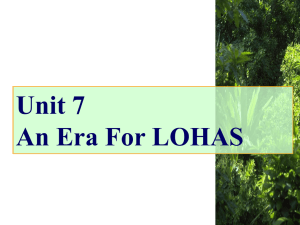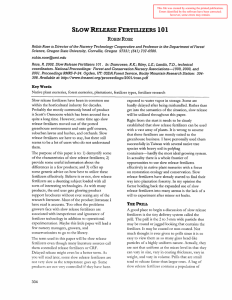Problematic Teaching in Science Classes
advertisement
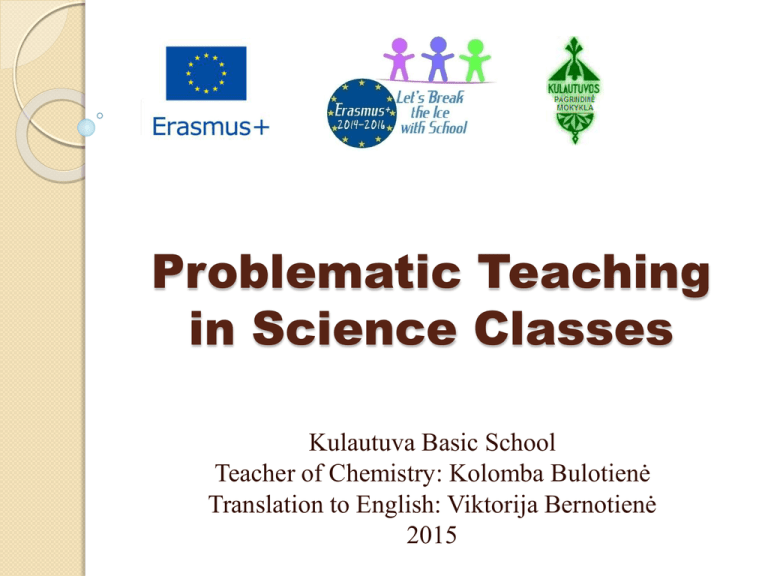
Problematic Teaching in Science Classes Kulautuva Basic School Teacher of Chemistry: Kolomba Bulotienė Translation to English: Viktorija Bernotienė 2015 „To foster everyone‘s creativity not in order for everyone to become artists, but for everyone to avoid being slaves“. G. Rodary. „The Grammar of Fantasy“ One of the main targets of the present day school is to help a child foster his or her competence of creativity, which enables to think and act originally, productively, in a flexible and purpose orientated manner. In other words, school should raise a thinking, able to solve the problems, independent, dashing and free person. The main concepts Education should firstly remove the contradictions between the teacher and the student. Relations with students should be based on partnership. Life has a meaning when it is based on communicating. People teach each other by going in between the world and the well known objects. Problemic thinking This is a constructive attitude towards learning. While learning in this way the existing knowledge is applied in order to identify what skills are still missing. How to plan a problemic lesson? Choose teaching targets The program and the textbook may serve as helping tools. Make sure, that you explain what is going to be evaluated and under what conditions the task should be accomplished. Submit the exact valuation criteria of when the task is considered to be successfully accomplished. Evaluation While forming the target, it should be clearly identified, how the pupils would show what they have learned – in a written, oral or other forms. If the lesson takes more than one day, a formative valuation might be applied. Form a question or a problem Try to find or form the main open type question, that would need several tools to solve it. If it is possible, such a question should be able to attract student‘s attention and they should care of it. Only then they would be motivated to find the solution. Identify what sourses the students can use in order to accomplish their task ( textbooks, the Internet, journals, student‘s own exercise-books, etc.) Decide, how much time would it take to solve the problem (one or few lessons). The phases of problematic teaching 1. Read and analize the problematic situation. 2. Create the formula for the problem. 3. Name the actions, solutions and hypothesis. 4. Present the data / conclusions. A successful lesson Subjects: Chemistry. Biology. Theme: THE EFFECT OF FERTILIZERS TO THE ENVIRONMENT The target of the lesson: While analysing informative texts and booklets, identify the effect of fertilizers to the environment and alive organisms. The planning of the lesson Time Activities 5 min. 5 min. Teacher presents the situation and uses visual aids. The problem being raised. The teacher gives questions so that the students could evaltuate the problem. The students think of the plan to solve the problem. They work in groups of 5 people. The plan to solve the problem is presented. Each group presents their plan and discuss it. Solving the problem – students work in groups. Groups present the solutions to solve the problem. 5 min. 5 min. 15 min. 10 min. Motivation and the analysis of the situation Fertilizers are needed for plants, however overusing them pollutes the environment – the soil and water. Nitrates are being stored in plants and their overdosing might harm people‘s health. So, are fertilizers friends or, on the contrary – enemies? Imagine, that some of you are specialists of farming, some are ecologists, the third one – biologists, the fourth ones – consultants of health. Tasks: Describe the positive and negative aspects of fertilizers‘ effect towards environment. 2. Define the importance of micro and macro elements for plants. 3. Find out: a) The effect of fertilizers‘ surplus or deficiency for plants; b) What is needed to be known of nitrates and nitrites. 1. Means of teaching: The packet of slides ( how fertilizers effect plants); Informative texts and booklets. Methods: Integration between subjects. Group work. Independent work. Involving type of the lesson. Creative tasks. Place, form, number of students: Kulautuva Basic School, 10th form, 18 students. Students‘ activities ,,Ecologists” have analized the informative text about the harm of fertilizers. Students‘ activities ,,Farmers” have analysed the text about the benefits of fertilizers. Students‘ activities ,,Biologists-chemics” have generalised the information about micro and macro elements and the consistance of fertilizers. Students‘ activities ,,Specialists of health” have analysed the booklet „ What we need to know about nitrates and nitrites“. Students‘ activities All the groups present their solutions for the problem. The strategy for teacher‘s activity and questioning the students. The tasks used. Evaluation. The teachers have provided a chance to gain the skills that will be valuable in the future activities and life of the students. The questions have motivated to solve the problem in the most rational way. The teachers have paid attention to the urgency of the topic in the present day life and in this way they have increased the level of students‘ motivation. The tasks were concentrated on the problem. They were connected to the proffessional activities, because students had to imagine they were the representatives of certain proffessions. The tasks were evaluated by the classmates. The tasks and the lesson were treated extremelly positivelly by the students of the class. Thank you for your attention!
